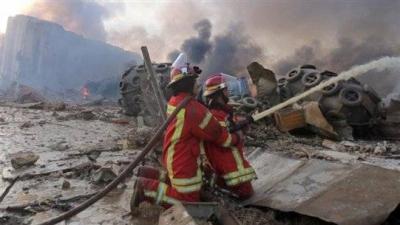One hour before the explosion on August 4, precisely at 5:05 PM, a call from the Beirut Police was received at the operations room of the fire brigade in Karantina, requesting assistance to extinguish a fire in the Port of Beirut, without providing any additional information. Quickly, a team of 10 firefighters (Shirbel and Najib Hitti, Shirbel Karam, Joe Bou Saab, Rami Kaki, Mithal Hawwa, Ralph Malahi, Eli Khazami, Joe Noun, and Sahar Faris) rushed to the location of the fire, which after an hour transformed into what resembled an inferno, turning the members of the fire brigade into martyrs. The team went that day to a "unknown incident," as described by First Lieutenant Ali Najem, the head of the Public Relations Department of the Beirut Fire Brigade. An incident that remains mysterious to this day in its details, as none of these martyrs, whose fate hung in the balance for more than 12 days after the explosion, survived to recount what happened or whether anyone accompanied them at that time to hangar number 12.
The tragedy of the Karantina fire brigade also cascaded into a disaster for its center adjacent to the port, which was completely destroyed two years ago, leading its members to rely on tents set up on the rubble. Najem recalls that period, recounting how the glass operations room was completely damaged, and its members sustained injuries ranging from minor to severe. After the funeral of the martyrs to their final resting place, a decision was made to reorganize and restructure the members of the brigade, leading to a phase of psychological rehabilitation that the remaining members needed, especially those who were given a second chance at life after being swapped at the last moment with their fallen colleagues.
**Another Fire Again**
This tragedy that befell the brigade did not deter them from answering the call of humanitarian duty. Despite the horror of the explosion and the tremendous loss represented by the martyrdom of an entire team, the members once again demonstrated their commitment by heading to the port to extinguish another fire. This occurred a month after the August 4 explosion, during a fire in the free zone of the port. Najem openly admits that he initially tried to prevent his team from going to the fire site "so we wouldn’t face another blow." He closed the main iron gate and the firefighters hesitated until confirming the fire, after assigning one of the members to scout the area on a motorcycle. Upon confirming the outbreak of the fire, Najem opened the gate, and as he describes, the members jumped over it, rushing with high spirits to fulfill their humanitarian mission, stating, "Our message doesn’t end at martyrdom."
In the outdoor courtyard of the center, Najem suggests conducting the press interview to seek additional ventilation, as ascending to the first floor of the building where the offices and operations room are located means only having illumination without any kind of air conditioning in this hot weather, despite the presence of a solar energy donation. This brings us to inquire about the assistance and equipment received by the center over the past two years. Regardless of the perspective, one encounters the names of international and local entities that provided donations to the center. It is well-known that the center continues to suffer from a severe shortage of equipment and supplies due to official neglect, which has sometimes led to the martyrdom of its members, as happened seven years ago in the "Mar Elias" area.
**Donations... Not Enough**
We ask Najem about the donations provided to the center and whether they would help them in fulfilling their humanitarian missions. It becomes clear that most of these donations do not meet actual needs, as time has passed since they were received, such as the ten used vehicles granted by the Canadian government, which can only accommodate two people, while extinguishing any fire requires five individuals, as Najem confirms. Consequently, members rely on another small vehicle to transport the rest. Additionally, donations of firefighting clothing were not new, approaching their expiration time, and the communication devices also did not form a complete network to facilitate communication among the members.
It is indeed a grim reality, compounded by the current economic crisis, where the sector faces a shortage of equipment, resorting to compensating with its human resources while placing their lives in peril every time they confront fires, "We work with living flesh," and "Every firefighter is a living martyr." Along the road leading to the fire brigade center, the images of the martyrs painted on an adjacent mural come into view. These images remain alone among possessions and items that were obliterated due to the explosion's force; the explosion left nothing to honor the brigade members and the families of the martyrs, preserving the sleeping places of their loved ones or retaining their personal belongings. Only a red helmet was found at the site of the martyrdom near hangar number 12, which Najem placed in his office to commemorate the martyrs, while its owner remains unknown.




